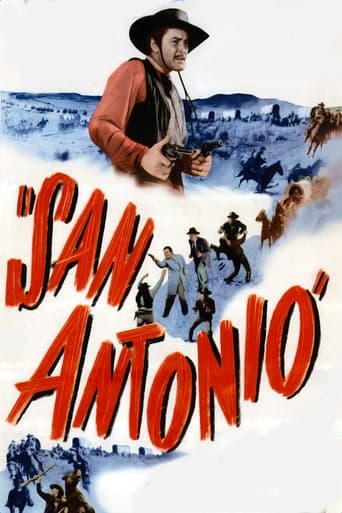weezeralfalfa
Hero Clay Hardin's(Errol Flynn) first and last scenes with gorgeous stage entertainer Jeanne Starr(Alexis Smith) involve him climbing through the window of a traveling stagecoach, after transferring from his horse. They thus serve as a sort of running gag. The first of these episodes serves as the equivalent of Flynn's swinging down on a vine from a tree perch to surprise a royal outing through Sherwood Forest, in "The Adventures of Robin Hood". Hardin then proceeds to convince the neophyte passengers that he is an asset in protecting them from a locally notorious badman named Clay Hardin. Typical Flynn shenanigans! Also in this stage are Jeanne's companions Sacha Bozic(the immimical "Cuddles" Sakall), who serves as her manager and orchestra conductor, and Henrietta(Florence Bates), who is like her mother. They have been contracted to provide entertainment at the Bella Union saloon, in San Antonio. I enjoyed this film, for the most part. In fact, it's one of my favorite westerns, that seems to get better with each viewing, mostly on Encore Westerns, at present. Also, available on DVD as part of Flynn's (incomplete) westerns collection. Alexis is superb as a feisty classy entertainer and woman, although her singing was dubbed. The music is first rate for a western. The presence of 3 very different European or Australian -bred actors, all quite charismatic, helps distinguish this western from others.The story is mainly about a war in south Texas between cattle ranchers and a huge rustler conglomerate headed by one Roy Stuart, who also owns the main San Antonio saloon:Bella Union. Many ranchers, including Hardin, have been ruined and sometimes killed by this cartel. Thus, Hardin has been hiding out in Mexican Laredo, across the Rio Grande from Texan Laredo. He has killed one of Stuart's henchmen sent to finish him off and apparently to drive stolen cattle across into Mexico. Serendipitiously,from this body, Harden recovered a notebook describing in detail the recent rustling activities of this cartel, thus providing the possible basis for legal proceedings against it. Longtime friend Charlie Bell(John Litel) joins Hardin as they cross the Rio Grande into Texan Laredo, where they kill two of Stuart's men sent to kill them. On to San Antonio, where Hardin makes a surprise appearance, having been reported as dead.Hardin weighs his options of trying to jail the kingpins via legal proceedings, motivating the US cavalry to suppress the gangs, or organizing the remaining ranchers into vigilante action. Meanwhile, Bell is murdered by Stuart's saloon manager, Legare, who recovers the incriminating notebook, but whose complicity in the murder is not immediately apparent, even to Stuart.The army cavalry is forced to bow out. Thus, Hardin decides that a showdown between an aggregation of ranchers and rustlers is his best option. This occurs at the Bella Union, where a massive brawl and shootout between the groups occurs, essentially destroying Stuart's establishment.Stuart and Legare escape into the adjacent Alamo ruins, followed by Hardin. It's a 3-way gun battle in the dark, as Stuart and Legare actually detest each other. It's not over yet, as an obligatory horse chase and fist fight follow. Now, Hardin just has to convince his fleeing lady love to return to start a new life. It didn't take much convincing. The interspersed 'action' sequences, involving shootouts, murders, brawls and fistfights, I thought were generally among the least interesting features of the film, although I appreciate that many viewers expect these in a western. At 35, Flynn still looked good, and is in top form in the various facets of his personality. Just prior to the big saloon brawl, he walks menacingly in front of the lineup of opposition, then kicks the backwards-leaning chair from under one, sending him sprawling. This is the defiant equivalent of throwing that deer carcass down in front of Prince John, as Robin Hood.This is one of 4 films in which Alexis costarred with Flynn. With her flaming hair, gray-green eyes, and often spectacular outfits, she was made for Technicolor, which we enjoy in this film and the later, much shorter, "Montana" western. Sakall also returned for the latter film, although he disappears half way through it. Already a practiced actor in his native Hungary, Sakall appeared as a distinctive emotional English-mangling senior character actor in many films in the '40s and early '50s, including many lesser known musicals. Along with Carmen Miranda and Desi Arnes, for example, his thick imperfect(to say the least) English was presented as cute, although some viewers find him irritating.Veteran actor Paul Kelly makes a cold, creepy, rock-jawed mostly silent, villain, in contrast to his urbane partner/nemesis: Victor Francen, as Legare. Their 'reluctant buddy' relationship I think quite interesting. Music-wise, the new "Some Sunday Morning" rightly dominates. It's about anticipating a marriage ceremony. Alexis does it nicely on stage, appropriately followed by a male quartet echo. Later she does "Somewhere in Monterey" on stage, interrupted by the big brawl. I also enjoyed the "Mexican Hat Dance" and, in the background, the classic romantic standard "La Golandrina".Hardin might have been loosely modeled on Albert Fountain, who headed a successful concerted effort by a volunteer militia to clean up NM's chronic rustling problem, after the skeletal territorial judicial system and the army cavalry proved inadequate or unwilling to solve the problem.
uwcharlie
Unlike some of the other comments above, I will give this movie great marks for plot, main actors, character actors, story line, suspense, technical proficiency of the director and beauty of the scenery and sets. Admittedly, maybe not Errol Flynn's best, but nothing to be ashamed of either. I saw other comments that Alexis Smith dubbed her singing, don't know how that was known, but my opinion is that this was her own work. You never lose interest from start to finish. The colors in this Technicolor feature are the best I've ever seen of the time period. Great movie. I have it on VHS, would like to get it on DVD but it seems to have disappeared from the marketplace.



